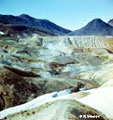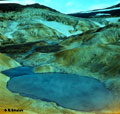1000-15
Bolshoi Semiachik
Coordinates of Bolshoi Semiachik (Zubchatyi) volcano: 54°19' N, 160°01' E, summit elevation 1739 m
Bolshoi ("Big") Semiachik massif is a group of late Pleistocene-Holocene stratovolcanoes and lava domes located within a large mid-Pleistocene caldera. The most prominent edifice of the massif is a late Pleistocene volcano Bolshoi Semiachik (or Zubchatyi) (Fig. 1). Holocene activity of the massif was limited to several lava domes. The massif hosts a hydrothermal system, one of the largest in Kamchatka.
One of the Holocene domes, Ivanov, was formed in early Holocene, 8500-9000 14C years BP. The dome has no lava flow and looks like a real well-shaped dome (Fig. 5). At first, we did not know how to date it since no cover of later tephra layers could stay on its steep slopes. However, a pit dug just near the dome exposed a layer of pumiceous andesite lapilli, which lay between marker tephras KRM (7900 14C years BP) from Karymsky caldera and so called "lower yellow ash" (about 9500 14C years BP). This lapilli layer pinched out with distance from the dome and was obviously associated with its formation.
Two other Holocene domes, Ezh ("Hedgehog") and Korona ("Crown") gave rise to long lava flows and associated lahars (Fig. 2 and 5). They were formed about 5600 14C years BP: the lowermost marker tephra layer overlying lava flows and lahar deposits of both domes is AV5 (5600 14C years BP) from Avachinsky volcano. In addition, pumiceous tephra of the eruption was found in a peat section, where it lies below AV5 but above a peat layer dated at 5620±50 years (Braitseva et al., 1995).
Volcanic products of the Holocene eruptions are low-potassic andesites.
Bolshoi Semiachik massif hosts several solfatara fields. Solfatara activity within these fields is manifested by jets of overheated vapour, boiling mud and water bowls, heated areas. Most of thermal fields are located in the central part of the massif, at the western slopes of Central and Bolshoi Semiachik volcanoes. The eastern part of Burliashchii thermal field (Figs.3 and 4) hosts strong steam jets with temperatures up to 137° C. Hot springs also occur at the outer slopes of the massif, about 8 km southeast of Bolshoi Semiachik volcano. Central Semiachik thermal field (Fig. 5) hosts Chernoe ("Black") steaming lake (Fig. 6).
Central part of the massif (elevation of about 1000 m) hosts peat bogs. They started to form about 9500 14C years BP and contain multiple tephra layers from different volcanoes, including more than ten key markers (SH2 and SH3 from Shiveluch; OP from Baranii Amphitheater; KS1 and KS2 from Ksudach; AV1, AV4 and AV5 from Avachinsky, KHG from Khangar; KRM from Karymsky caldera; "lower yellow ash" from an unknown source; "one-grain thick" KO tephra from the Kurile Lake caldera, etc.
Literature
Leonov VL, Grib EN (1991) Bolshoi Semiachik volcano. In: Fedotov and Masurenkov (Eds) Active volcanoes of Kamchatka. Nauka Publishers. Moscow. Pp. 144-159
Vakin Ye.A. (1976) Hydrothermas of Bolshoi Semiachik volcanic massif. In: "Hydrothermal systems and thermal fields of Kamchatka. Vladivostok. Pp. 212-236 (In Russian)
Braitseva OA, Melekestsev IV, Ponomareva VV, Sulerzhitsky LD (1995) The ages of calderas, large explosive craters and active volcanoes in the Kuril-Kamchatka region, Russia. Bull Volcanol 57/6: 383-402





